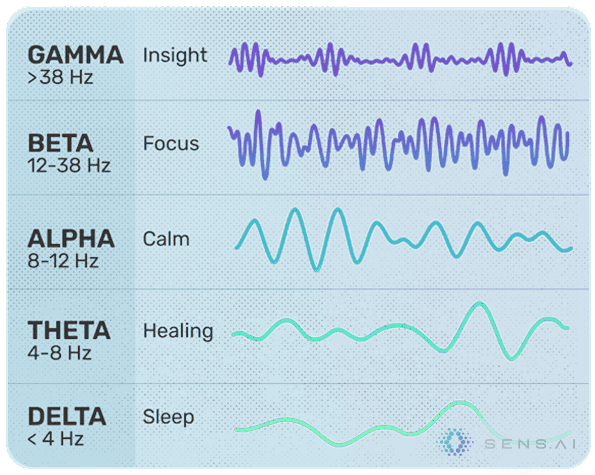Brainwaves
What They Are and Why They Matter

Your brain is never silent. It pulses with rhythmic electrical activity called brainwaves. These patterns influence everything from how you sleep to how you focus—and understanding them gives you a window into how your brain works.

What Are Brainwaves?
Brainwaves are the electrical patterns created by groups of neurons firing in synchrony. Measured in hertz (Hz), or cycles per second, these rhythms reflect different states of consciousness and mental activity.
Your brain naturally shifts between different brainwaves throughout the day—like gears shifting depending on what you’re doing.
Types of Brainwaves
Each type of brainwave operates at a different frequency and is associated with specific mental and physical states:
- Gamma (38+ Hz): Insight, complex processing, peak states
- High Beta (12–38 Hz): Stress, overarousal
- Beta (15–30 Hz): Active thinking, problem-solving
- SMR (12-15 Hz): Emotion regulation, steady attention
- Alpha (8–12 Hz): Calm focus, relaxed alertness, flow state
- Theta (4–8 Hz): Creativity, emotional healing, accessing the subconscious
- Delta (0.5–4 Hz): Deep sleep, recovery
Why Brainwaves Matter
Brainwaves play a key role in cognition, emotion, and performance. When your brainwave activity is balanced and flexible, you can move smoothly from focus to rest to insight.
But when patterns are stuck—like too much high beta from chronic stress—it can lead to issues like insomnia, anxiety, cognitive fatigue, and even burnout. Burnout often shows up as mental exhaustion, emotional detachment, and a sense of reduced accomplishment—all of which are reflected in unbalanced brainwave patterns.
Can You Influence Your Brainwaves?
Yes. You can change your brainwave state temporarily with neurostimulation. And over time, and with deliberate practice, brain training, you can control your brainwave patterns.
Neurofeedback and other forms of brain training have shown that it’s possible to strengthen underactive rhythms (like alpha for calm) or reduce excess patterns (like high beta for anxiety).
The goal isn’t to live in one state—but to build the flexibility to shift between brainwaves as needed. Mental agility, after all, comes from being able to move fluidly between states.


Your Brain’s Lighting System
Think of your brain as a smart lighting system—automatically adjusting based on what you’re doing and how you’re feeling. Each brainwave state is like a different setting, optimized for a different task.
- Delta is blackout mode: everything powers down for deep repair and regeneration.
- Theta is candlelight: soft, dreamy, perfect for imagination and subconscious insights.
- Alpha is soft daylight: calm, alert, and open to the moment.
- Beta is bright white LEDs: crisp focus for thinking, analyzing, and problem-solving.
- Gamma is a laser spotlight: all-in clarity, pulling together insights and big-picture understanding.
Just like lighting shapes how we experience a room, brainwaves shape how we experience the world — and ourselves.